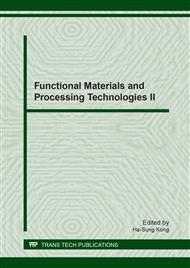[1]
A.I. Bulatov, Pressure Sealing of Oil and Gas Wells Cementing, Krasnodar, Prosveschenie-Yug, (2008).
Google Scholar
[2]
A.N. Popov, A.I. Spivak, T.O. Akbulatov, Technology of Oil and Gas Wells Drilling. Moscow, Nedra-Business-center, (2004).
Google Scholar
[3]
R.R. Daminev, R.N. Asfandiyarov, R.N. Fatkullin, Synthetic polyelectrolytes produced in Russia – Scopes and perspectives of application, Oil and Gas Engineering, 6 (2015) 431-432.
DOI: 10.17122/ogbus-2015-6-431-442
Google Scholar
[4]
A.U. Sharipov, E.N. Khafizova, Polymeric additives to grouting, VNIIOENG MCN, 9 (1991) 31-33.
Google Scholar
[5]
F.A. Agzamov, A.A. Kabdushev, S.F. Komleva, A. Bayutenov, Use of cement slurries with reduced fluid loss for well cementing in Kazakhstan, Pollution Research Paper, 35 4 (2016) pp.891-896.
Google Scholar
[6]
S.F. Komleva, B.S. Izmukhambetov, O.F. Kondrashev, N.A. Nogayev, Cement Slurries With Reduced Filtration Characteristics, Ufa, Monograph, (2008).
Google Scholar
[7]
D.P. Chzhu, OFI testing equipment: Equipment for testing of grouts and cement slurries, 2011, available at: http://www.epac-service.ru/analiticheskie-obzory/ofi-testing-equipment-oborudovanie-dlya-ispytaniya-burovyh-rastvorov-i-tamponajnyh-cementov/ (accessed March 14, 2017).
Google Scholar
[8]
ISO 10426-2:2003, Petroleum and natural gas industries. cements and materials for well cementing. Рart 2: Testing of well cements, 2003, available at: https://www.iso.org/obp/ui/#iso:std:iso:10426:-2:ed-1:v1:en (accessed March 18, 2017).
DOI: 10.3403/30141151u
Google Scholar
[9]
GOST 1581-96. Oil-well portland cement slurries, 1998, available at: http://download.beton.ru/cement/1581-96.pdf (accessed March 18, 2017).
Google Scholar
[10]
OFI Testing Equipment, Inc., Atmospheric Consistometer, Instruction Manual, 2013, available at: http://www.ofite.com/publications/instructions/ (accessed March 20, 2017).
Google Scholar
[11]
F.A. Agzamov, A.A. Kotok, Sh.Z. Rizvanov, A.M. Gataullin, Patent 2017111338/03 (020102). (2017).
Google Scholar
[12]
F.A. Agzamov, N.Kh. Karimov, B.S. Izmukhambetov, Condition and perspectives of disintegratory technology at well construction, Oil Industry, 3 (2003) 40-43.
Google Scholar
[13]
B.S. Izmukhambetov, F.A. Agzamov, B.T. Umraliyev, Application of Disintegratory Technology at Obtaining Powder Materials for Well Construction, Saint Petersburg, Nedra, (2007).
Google Scholar
[14]
F.A. Agzamov, G.V. Konesev, A.R. Hafizov, Application of disintegratory technology for the modification of materials used in the construction of wells. Part I, Nanotehnologii v stroitelstve, 9 2 (2017).
Google Scholar
[15]
V.I. Vovk, Additives based on Russian polycarboxylates, Concrete Technology, 3 (2013) 13-15.
Google Scholar
[16]
F.A. Agzamov, R.F. Davletshin, A.V. Belyaeva, Mechanism of plastifying agents in cement slurries, Oil Industry, 15 2 (2017) 8-13.
Google Scholar
[17]
F.A. Agzamov, B.S. Izmukhambetov, Tokunova, E.F. Chemistry of Cement Slurries and Grouts, Saint Petersburg, Nedra, (2011).
Google Scholar
[18]
A. I. Bulatov, V.I. Ryabchenko, I. A. Sibirko, N.A. Sidorov, Gas Shows in Wells and Protection from them, Moscow, Nedra, (1969).
Google Scholar
[19]
Bulatov, A. I. On the reasons of annular gas, water and oil shows. Gas Industry, 12 24-27.
Google Scholar
[20]
U.D. Mamadzhanov, V.E. Khalfin, Annular gas shows, Gas Industry, 1 (1963) 22-24.
Google Scholar
[21]
V.D. Malevansky, Open Gas Blowouts and Protection from them, Moscow, Gostoptechizdat, (1963).
Google Scholar
[22]
V.N. Fedorov, A.P. Averyanov, Study of vapor pressure drop in grouts, Oil and Gas Industry, 5 (2011) 48-53.
Google Scholar
[23]
A.R. Ingraffea, Fluid migration mechanisms due to faulty well design and/or construction: An overview and recent experiences in the Pennsylvania Marcellus play, 2012, available at: http://www.damascuscitizensforsustainability.org/wp-content/uploads/2012/11/PSECementFailureCausesRateAnalysisIngraffea.pdf (accessed April 14, 2017).
Google Scholar
[24]
A. Bonett, D. Pafitis, Getting to the root of gas migration, Oilfield Review, 8 1 (1986) 36-49.
Google Scholar
[25]
R. Rastogi, K.M. Suyan, V. Sharma, S. Dutta, Evaluation and identification of water sealant products as gas block additives for HPHT wells. Petrotech, 2010, available at: https://indiankanoon.org/doc/2161/ (accessed April 14, 2017).
Google Scholar
[26]
Schlumberger, Gas migration control engineering suite, 2007, available at: https://www.slb.com/~/media/Files/cementing/brochures/gas_migration_control_suite.pdf (accessed April 14, 2017).
Google Scholar


